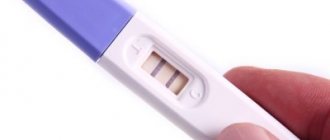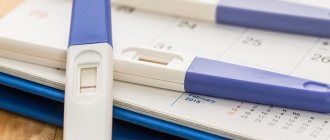How do pregnancy tests work?
Absolutely all pregnancy tests check whether there is a special Pregnancy Tests hormone in the urine or blood (if we are talking about a laboratory test) - human chorionic gonadotropin, abbreviated as hCG. It begins to be produced immediately after the fertilized egg attaches to the wall of the uterus.
If there is no pregnancy, hCG has nowhere to come from. If it is there, hCG will definitely be present.
Typically, the egg attaches to the uterus six days after fertilization. There is no point in doing a test during this period: it will not show anything. But then the hCG level increases quickly, doubling every 2-3 days.
With an irregular menstrual cycle
Provided that a woman has an irregular cycle, you initially need to know the time of ovulation. Indeed, in this case, it is difficult to determine when ovulation occurred, and, accordingly, how long after ovulation to do the test. You can determine the period of ovulation:
- using an ovulation test ;
- by the level of basal temperature (it increases);
- by the manifestation of signs of PMS (whether this sign can show ovulation depends on the individual characteristics of the female body).
Having determined what time of ovulation, you need to add 12 days to this day, after which an increase in hCG in the blood is already detected under the condition of pregnancy. A high sensitivity pregnancy test can be done on the 15th day.
But the most accurate results will be those obtained after the delay. That is, keep in mind that if you are 5 days late, it makes sense to take a test.
When to take a pregnancy test
Already 8 days after ovulation, during which the egg meets its sperm, the level of hCG becomes sufficient for pregnancy to be confirmed using a laboratory blood test.
In a few more days - that is, on the 10th-12th day after fertilization - the pregnancy will be detected by ordinary pharmacy tests.
Although the instructions for many of them promise an accurate result already on the first day of the delay, doctors advise not to rush Home pregnancy tests: Can you trust the results? . The reason is simple.
If you ovulate on the 10th–14th day of your cycle, then by the beginning of the next cycle at least 13 days will have passed since fertilization. This means that the test will signal you with two stripes.
However, ovulation may shift. If the egg was released on the 22nd day of the cycle, then by the beginning of the delay the actual gestational age may be less than 7 days. This means that even perfect tests will most likely not capture anything.
If your cycle is more or less than 28 days, things are even more confusing.
Therefore, in order to get the most accurate result, you should wait 5–7 days from the start of the delay.
If you are pregnant, the hCG level by this time will in any case be such that even the cheapest tests with low sensitivity will clearly recognize it
But even if you met all the deadlines, the test can still mislead you. For example, it will not see a high level of hCG and will show a negative result if there is an existing pregnancy, or, on the contrary, it will give two stripes, although it does not smell like pregnancy. To be fair, let’s say that it’s not so much the test that’s to blame for this, but you yourself. Five reasons for false-positive pregnancy tests.
What tests are there?
The result depends not only on the level of hCG in your urine, but also on how sensitive the drug is to this hormone. There are currently four types of tests that can help you determine the condition.
The most popular are still strip tests. These include Evitest and Frautest, quite famous among women, of German origin. These options have proven themselves well, since the manufacturer uses high-quality reagents. If you choose a cheap option, the result may be questionable, since cheap reagents are used in the production of an inexpensive product.
Strip tests are quite easy to use, but not always convenient. It is better for them to purchase a sterile container in which the urine will be collected. Then the drug should be lowered into it to a certain level and held for about five seconds. The result is determined after three minutes. Moreover, the time of appearance of the second stripe depends on the level of the hormone in the urine. The lower it is, the slower the band will appear. The manufacturer also often indicates that the result can be considered reliable if more than 15 minutes have passed. That is, if the second line appeared only after a quarter of an hour, then you should not trust the result. It is important to keep in mind that even a very pale second line indicates that you are about to give birth soon.
On what day will the drug show results exactly? You can use strip tests even before the delay from your last menstruation, but it is better to do this from the first day.
Tablet options come in a special box with holes. A small amount of urine - about four drops - is placed in one hole, and the result appears in the other. Two stripes may appear after a minute, or may appear only after ten. At what day of delay will the test show pregnancy? The tablet version can also detect pregnancy from the very beginning of the delay after the last menstruation, but it is not very convenient.
The inkjet option is much more convenient in this regard. It is very easy to do: just place the tip of the dough under the stream of urine, but you can do it as usual, after first collecting the liquid in a container.
The advantages of the inkjet version are its high sensitivity. But how accurately does it guarantee the correct result, and also for what day of delay can it show two bands? Usually it shows pregnancy a week before the expected menstruation.
The most modern are electronic, or digital, options. To make it, you need to place the tip of the test in the urine and wait three minutes. In this case, a positive result is determined not using traditional stripes, but using the “+” sign or the word “pregnancy”, which means “pregnancy”.
Why do rapid pregnancy tests lie?
You used an expired or damaged test
Express tests contain special highly sensitive substances that react to hCG levels. It is they who, when in contact with the urine of a pregnant woman, are painted with a bright second stripe or plus sign.
But if the test is expired or improperly stored, the sensitivity of these substances may decrease. As a result, they will give a negative result, which may turn out to be false.
What to do
Buy tests only in pharmacies, where, unlike supermarkets, they try to provide them with the correct storage conditions. When purchasing, be sure to check the expiration date.
You bought a test with low sensitivity
The sensitivity of rapid tests is indicated by numbers - 10, 20, 25, 30. These numbers indicate the concentration of hCG in urine (in mIU/ml) that they are able to detect. The higher the number, the less accurate the test. The most expensive and accurate options have a sensitivity of 10. But cheap ones may not detect hCG and deceive you by showing a negative result.
What to do
When purchasing a test, be sure to check with your pharmacist how sensitive it is. Also, this information can often be found on the packaging and always in the instructions.
You took the test this afternoon
It’s not for nothing that in the instructions for the vast majority of tests, the manufacturer talks about morning urine. It is more concentrated, there is more chorionic gonadotropin in it, which means the test will be more reliable.
In the afternoon, the content of hCG in the urine is lower.
What to do
Use the test exclusively in the morning, as the manufacturer instructs.
Did you drink a lot of water before taking the test?
Water dilutes the urine, which lowers hCG levels. The rapid test may not detect the hormone and give a false negative result.
What to do
Try not to eat or drink anything before the test.
You didn't look at the results in time
The instructions for each test stipulate the rules for its use. For example, like this: “The result can be assessed 4–5 minutes after the test, but no later than 15 minutes.” These minutes were not taken out of thin air.
The lower limit indicates the time it takes for the test to allow the sensitive substances it contains to react to the hCG level. If you look at a test earlier than the agreed upon date, the second line (or the plus sign in the corresponding window) may not yet appear and you will see a false negative result.
If you look at the strip after the time indicated as the upper limit, you risk getting a false positive result. Evaporated urine may leave a line that can easily be confused with the second line.
What to do
Before using the test, read the instructions and follow them strictly.
You are taking certain medications
Some diuretics and antihistamines affect the composition of urine, diluting it. This reduces the level of hCG, which means there is a risk of getting a false negative result.
Other drugs, on the contrary, can give you two stripes, although in fact there is no pregnancy. Such medications include:
- some tranquilizers and sleeping pills;
- anticonvulsants;
- drugs that enhance fertility.
What to do
If you are taking any medications on this list, you should not rely on a paper rapid test. To determine whether you are pregnant or not, do a laboratory blood test.
you are sick
If there is increased blood or protein in the urine, this may also affect the result of the rapid test. But it is important to note that this situation in itself is extremely unhealthy. Blood in the urine indicates problems with the bladder or kidneys; increased protein indicates internal inflammation.
Therefore, most likely, the erroneous two stripes on the test will be accompanied by increased temperature and/or discomfort in the genital area and kidneys.
What to do
Do not rely on a rapid test if you have a fever and pain in your lower back or lower abdomen. In case of such ailments, you should contact a therapist, gynecologist or urologist as soon as possible so as not to miss a serious illness.
You develop an ovarian tumor
Some types of tumors can trick the test into showing two lines.
What to do
Once you receive a positive result, do not delay your visit to the gynecologist. The doctor will conduct research during which he will determine the actual duration of pregnancy (if any) or send you for additional tests and to specialized specialists.
How to choose the right test?
Pregnancy tests offered in the pharmacy chain are divided into several varieties:
- jet;
- tablet;
- strip strips;
- electronic (digital).
The most accessible and popular is the “striped friend of girls”; men also know about them.
If you send your husband or friend to the pharmacy for such a “device,” he will probably buy exactly “two strips.” The most advanced husbands may ask the pharmacist “what’s the difference?” and listen to a short “sermon” about the most expensive and accurate tests. Most likely, in this case, he will buy digital, and not the cheapest - strip strips. In order for such a test to “rinse”, it must be lowered into a container where morning urine is collected - it contains the highest concentration of hCG. Results will be available in 5-10 minutes. If the test does not show a second line next to the control line, exactly the same in width and color, you are not pregnant.
At what stage can you find out about pregnancy with a stripe test? Unfortunately, they are not very sensitive. In the best case, during the delay or later, when the concentration of the control hormone rises to a level above 20 mIU/ml.
The tablet test is the same case where you need to drop urine (a pipette is included). The sensitive reagent is located in a special window, where the control “dose” of urine should fall. The chemical reaction occurs quite quickly. These tests are convenient and accurate, but the degree of sensitivity is approximately the same as the more primitive “dip” analogue; the gestational age is “not known.”
Experts consider inkjet tests to be the most sensitive. They have nothing to do with inkjet printers or other devices. They just need to be placed under a fresh stream of urine.
Attention: If you see the designation “10 mIU/ml” on their packaging, know that this is a highly sensitive system. Their error is minimal, their undoubted advantage is their use in any conditions. How early can you tell if you are pregnant? Before the delay.
How to take a pregnancy test correctly
- Read the instructions. And follow it, of course!
- Remember the rule: if you are healthy and the test shows a positive result, the probability of pregnancy is 99%. A negative result may be false up to a week after the delay.
- Choose tests with a high level of sensitivity. 10 is ideal.
- Do the test in the morning, not in the afternoon, and especially not in the evening.
- Try not to drink at least an hour before the test.
- Do not rely on the test if you are taking the medications listed above or if you have fever or lower abdominal pain.
- Buy two tests at once so you can double-check the results.
- If rapid tests contradict each other, don't wonder what's wrong. Get a laboratory blood test to get a reliable result.
Important! A positive test, even if you have been waiting for it for a long time, is, alas, not yet a reason to rejoice. An increased level of hCG in the urine can also be recorded during an ectopic or frozen pregnancy. Therefore, after receiving two strips, go to the gynecologist as soon as possible.
On what day of missed period should the procedure be performed?
https://tse2.mm.bing.net/th?id=OIP.1RImeD7dKoZ3hCSdSiFtkQEsDW&pid=15.1&P=0&w=219&h=157
The sensitivity of the test itself is of great importance. Very often they have a sensitivity of 20-25 mIU/ml; such strips can recognize the level of hCG only after a missed period. And there are also tests that are more sensitive 10 mMi-ml, these are able to show conception 7-10 days after the expected fertilization.
These tests are more expensive, but they are very effective and can be used a few days after an unprotected act. The hCG level grows in a woman’s body better and faster than in urine, so it is possible to determine fertilization almost at the earliest stages of conception.
Many women's forums show videos of modern tests, and you can find out the minimum period during which this procedure is carried out to determine pregnancy.
They also show how the hormone grows in the first days of implantation, and how it behaves every day.
- Implantation occurred on the seventh day, the hormone level will be 2 mUI.
- The next day the hormone shows 4 mUI.
- The ninth day of implantation is 8 mUI.
- On the eleventh day the hubbub crosses the border – 25 mUI.
And only after this indicator, you can use the test. The level of the hormone - hCG in the urine can be detected, since it is already elevated.
Terms of pregnancy: obstetric and embryonic
The gestational age, which is indicated in the maternal passport, which is filled out when the expectant mother is registered at the antenatal clinic, differs from the period that has actually passed since the day of conception, as a rule, by 14 - 15 days.
However, there may be other options, for example, for 7 – 21 days, depending on the length of the menstrual cycle. And this is completely normal, since we are talking about different periods: obstetric and embryonic.
Embryonic term
The embryonic gestational age, which is also called “real”, “true”, is counted directly from the actual date of conception, which coincides with the date of ovulation. Therefore, if a woman keeps a calendar of her ovulatory cycle, then determining the day of conception is not difficult.
Pharmacy pregnancy tests, which show the period in days, reacting specifically to changes in the woman’s body after conception, also “mean” the embryonic period.
And, as a rule, for compliance with a certain embryonic age, the parameters of the fetal embryo are assessed, namely, its coccygeal-parietal size, using ultrasound performed in the early stages.
Obstetric term
The concept of “obstetric” gestational age is used when they obviously mean not the exact age of the fetus, but the period (in weeks) that has passed since the onset of the last menstruation, after which conception occurred.
Historically, it is the obstetric gestational age, as easily determined by the date of the first day of the last menstruation, that is used as a control to select the time for the appointment of all screening examinations for the expectant mother (including blood tests, urine tests, consultations with specialists, etc.), and also to establish the expected date of birth.
Whereas the day of the “date” of the egg with the sperm can be definitely known only in the case of IVF.
However, having recorded the obstetric age of pregnancy in the mother’s passport, the doctor asks the expectant mother about the expected day of conception and sends her for a blood test to determine hCG.
The earliest signs of pregnancy in the 1st week))) I’m already looking for them)))
... How do you know if you're pregnant? It’s very simple - pay close attention to the signs of pregnancy, and already in the very early stages. Knowing your body well, you can recognize the first signs of pregnancy even before your period - for example, there are many cases when women knew in advance that they were pregnant - they simply felt it, as we intuitively feel, for example, the approach of a thunderstorm through unnaturally calm air. The same is true in the case of pregnancy - it is often possible to recognize the signs of pregnancy already in the first week, when the very first signs of pregnancy appear. Very often, after two lines appear on the test, a woman says to herself: “Wait! But I felt for a long time that I was pregnant!” For many, a positive test is not a surprise, but rather a confirmation of what intuition already suggested. What are the first changes in the body that give our subconscious a reason to suspect pregnancy when we ourselves are still driving away all sorts of assumptions, saying to ourselves: “Well, there’s no point in fantasizing. You need to at least wait for the delay!” The article collected and analyzed not only the classic signs of pregnancy, but also the signs of pregnancy described by participants in one of the pregnancy planning sites BEFORE THEY KNEW ABOUT PREGNANCY and during the week after. Light spotting Discharge can range from light bleeding to just a few brown drops or even just a “yellowish mark” on the toilet paper. Usually the thought that accompanies them is: “Somehow my period is early this time” or “well, my period is here.” This implantation bleeding is one of the earliest signs of pregnancy. Approximately 6 to 12 days after conception, the embryo is planted on the uterine wall. For some women, this process is accompanied by bleeding, but for many, no discharge appears at all, which is also normal. Small discharge may periodically appear again on days when the fertilized egg is more actively “implanted” into the wall of the uterus. Most often they have a “creamy” consistency, yellow or pink. They may appear after a delay, but in this case it is necessary to consult a doctor to eliminate the threat of miscarriage. Also, pink and yellow discharge can be caused by cervical erosion, which intensifies with the onset of pregnancy. Cervical erosion is a violation of the integrity of the vaginal part of the cervix. During pregnancy, it acquires an even brighter red color due to increased blood circulation to the cervix, and can bleed easily on contact. Increase in basal temperature, implantation depression When measuring basal temperature, a sign of pregnancy is the so-called “implantation depression” - a sharp decrease in temperature for one day in the second phase. This is one of the signs most often observed in charts with confirmed pregnancy. This retraction can occur for two reasons: firstly, the production of the hormone progesterone, which is responsible for raising the temperature, begins to decrease from the middle of the second phase; with pregnancy, its production resumes again, which leads to temperature fluctuations. Secondly, during pregnancy, the hormone estrogen is released, which in turn lowers the temperature. The combination of these two hormonal shifts leads to the appearance of implantation retraction on the graph. A basal temperature above 37 degrees is also considered a sign of developing pregnancy. True, it remains elevated only for the first few weeks, until the placenta begins to function. Feeling unwell Many women who do not know about their pregnancy believe that they have caught a cold and are sick. This is due to the fact that in the first trimester of pregnancy a woman’s body temperature is elevated; Fatigue also increases. Therefore, there is a feeling that the woman is getting sick. But many people do get a little “sick,” probably due to a slight decrease in immunity. Complaints of a sore throat and runny nose are common. In this case, the main thing is not to treat yourself with strong medications that are contraindicated during pregnancy and to use more traditional medicine. Increased breast sensitivity Swelling or increased sensitivity of the breast is a common sign of pregnancy that appears 1 to 2 weeks after conception. A woman may notice how her breasts have changed; they react to every, even minor touch, hurt or swell, sometimes it is almost impossible to touch them. But there are pregnant women who “don’t feel” their breasts in the first weeks of pregnancy, and some, on the contrary, are surprised that their breasts “strangely enough do not hurt before menstruation” and then find out about the pregnancy. Pregnancy is also indicated by darkening of the skin around the nipples. Feeling of “fullness”, heaviness in the pelvic area During pregnancy, blood flow to the pelvic organs increases, the uterus slowly enlarges. Therefore, many pregnant women “feel” their uterus from the first days of implantation and attribute it to the first signs of pregnancy. The other, less pleasant side of the coin is the appearance of hemorrhoids. For many, it appears in the second half of pregnancy due to the pressure of the growing fetus, but some expectant mothers (especially those who have given birth before) encounter this problem already in the first weeks of pregnancy, all due to the same increased blood flow. Tingling in the uterus during pregnancy Many pregnant women notice periodic tingling in the uterus in the first or second week of pregnancy. Fatigue/drowsiness, lack of concentration Feeling tired or apathetic is a common sign of pregnancy before menstruation, which can appear as early as the first week after conception. One of its reasons is the increased production of the hormone “progesterone”; plus a general restructuring of the body for pregnancy. Progesterone depresses the psyche, which manifests itself in depression, irritability and drowsiness. Starting from the 10th week of pregnancy, the active hormone-producing function of the placenta begins. In accordance with the increase in pregnancy and fetal growth, in addition to progesterone, the level of estrogen increases, which has a stimulating effect on the psyche, and drowsiness disappears. Either hot or cold Another early sign of pregnancy can be considered that you feel either hot or cold and, accordingly, you can’t keep warm in three pairs of woolen socks, or you feel hot when outside +10, and you're wearing just a T-shirt. This is due to increased body temperature in the first trimester of pregnancy and decreased blood pressure. Interestingly, many people note redness of the face in the evening. Restless sleep Many women who do not yet know about their pregnancy note that their sleep has become more restless. In the evening, they begin to go to bed earlier, and often simply “pass out”, but they wake up on their own at 6-7 in the morning and cannot fall asleep again. There is a feeling of “brokenness” even after a full night’s sleep. Nausea, increased salivation, aversion to smells This classic sign of pregnancy often occurs between 2 and 8 weeks after conception. Some lucky women do not experience nausea throughout their entire pregnancy. However, 50% of women experience aversion to smells, nausea and vomiting in early pregnancy. Vomiting during pregnancy can occur several times a day and is often accompanied by nausea and drooling. Vomiting is accompanied by a decrease in appetite, a change in taste and olfactory sensations. It is considered as a disorder of the neuroendocrine regulation of body functions, and the leading role in this belongs to a violation of the functional state of the central nervous system. However, such vomiting can also be caused by factors of an intragastric nature, often being an important symptom of dysfunction of the digestive system. Along with vomiting during toxicosis in early pregnancy, due to severe irritation of the salivary center, drooling is often observed, which can lead to a significant and undesirable decrease in the pregnant woman’s body weight (up to 2-3 kg within one week). If copiously secreted saliva is swallowed, then, when it enters the stomach, it changes the acidity of gastric juice and causes disruption of digestive function. It is important to consider that vomiting is a protective reaction, since in this case the body is freed from toxic and rejected substances. This is an evolutionary adaptation in response to harmful influences. At the same time, along with vomit, the body loses saliva, digestive juices containing proteins necessary for the body (including enzymes), electrolytes, and in some cases, partially or completely, the food taken. In this regard, with frequently repeated vomiting, water-salt, protein and fat metabolism, the balance of vitamins and minerals, and the activity of the endocrine glands are gradually disrupted. Lower back pain Mild pain, “lumbago” in the lower back, in the sacral area can also indicate early pregnancy; however, mild pain occurs periodically throughout the entire period of pregnancy. In the early stages, “lumbago” often appears from the pelvic area to the legs. Headaches and migraines A sudden increase in hormone levels in the body can cause headaches in early pregnancy, and therefore serves as an indirect sign of pregnancy. Usually, by the end of the first trimester, the headaches subside and leave the pregnant woman to enjoy her position. Slight swelling of the hands Progesterone promotes the retention of salts and fluid in the body, which can lead to slight swelling when, when you clench your hand into a fist, you feel that your fingers have become thicker. Bloating, gas, intestinal disorders A common sign of pregnancy is a noticeable increase in abdominal circumference in the very early stages of pregnancy, when the uterus is still slightly enlarged, associated with intestinal bloating. During the digestion process, gas formation always occurs in the intestines. During pregnancy, the intestines become more “lazy,” its peristalsis slows down, and, consequently, the rate of movement of intestinal contents decreases, its bloating increases, and constipation may appear. This is facilitated by hormonal changes characteristic of pregnancy, which leads to an increase in blood supply to the vessels of the abdominal cavity and, as a consequence, to a slight swelling of the intestinal walls. Frequent urge to urinate Frequent urination during the day and at night is a common early sign of pregnancy. It should be noted that there are no other painful sensations (pain, stinging, burning). These phenomena disappear by the 4th month of pregnancy. This is caused by significant hormonal changes that accompany pregnancy. The increased level of female sex hormones at first contributes to a significant rush of blood to the pelvic organs. Overflow of blood vessels causes temporary changes in the functioning of the kidneys, ureters, and bladder. These phenomena decrease in the second trimester of pregnancy, however, they can safely be attributed to frequent signs of pregnancy. Low blood pressure A common phenomenon during pregnancy is a slight drop in blood pressure. If a woman had low blood pressure before pregnancy, then during pregnancy periodic states of a significant decrease in blood pressure (less than 90/60 mm Hg) are possible and, as a result, weakness, dizziness, headache, and fainting. Deterioration of health usually occurs during prolonged standing, when taking hot baths, during prolonged stay in a stuffy hot room, on an empty stomach. For pregnant women with a tendency to hypotension, the daily routine is especially important: night sleep 9-10 hours and daytime sleep 1-2 hours. An increase in appetite/craving for certain “Zhor” foods often accompanies incipient pregnancy and is considered one of its signs. You may not necessarily feel the urge to indulge in pickles or vanilla ice cream, but many pregnant women still have cravings for certain foods. An increase in vaginal discharge, the appearance of thrush. The secretion of secretions from the vagina increases - this is due to the increasing blood supply to the pelvic organs. During pregnancy, the concentration of hydrogen ions in vaginal secretions increases, which protect the expectant mother’s body from harmful microorganisms entering it. But, unfortunately, yeast fungi reproduce well in this environment, and because of this, pregnant women often develop thrush (candidiasis), which must be cured, otherwise the fetus may become infected, and during childbirth the tissues of the birth canal will tear more easily. And finally, delayed menstruation. Delayed menstruation/menstrual irregularity is the most well-known and common sign of pregnancy that forces a woman to take a pregnancy test. During pregnancy, a woman experiences a one-month delay in menstruation. Many pregnant women experience bleeding, but usually the period ends quickly and is less intense than usual. Delayed menstruation can be attributed to many reasons other than pregnancy. However, if you are sexually active and have a delay, it is better to take a pregnancy test. Happy pregnancy and easy birth!











